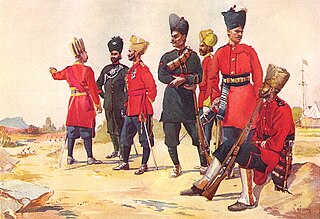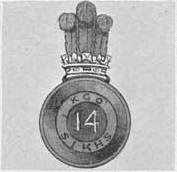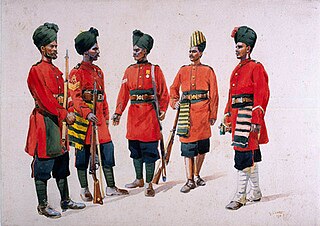Related Research Articles

The 2nd Queen Victoria's Own Rajput Light Infantry, commonly shortened to 2nd Rajputs, was a regiment of the British Indian Army. Raised in 1798, it was amalgamated with five other Rajput regiments in 1922.

The Imperial Service Troops were forces raised by the princely states of the British Indian Empire. These troops were available for service alongside the Indian Army when such service was requested by the British government. At the beginning of the 20th century, their total numbers were about 18,000 men.
The 108th Infantry were an infantry regiment of the British Indian Army. The regiment traces their origins to 1768, when they were raised as the 1st Battalion, Bombay Sepoys.

The 112th Infantry were an infantry regiment of the East India Company's Bombay Army and later the British Indian Army. The regiment traces their origins to 1796, when they were raised as the 2nd Battalion, 6th Regiment of Bombay Native Infantry.

The 113th Infantry were an infantry regiment of the British Indian Army. The regiment traces their origins to 1800, when they were raised as the 1st Battalion, 7th Regiment of Bombay Native Infantry.

The 104th Wellesley's Rifles were an infantry regiment of the British Indian Army. They could trace their origins to 1775, when they were raised as the 5th Battalion, Bombay Sepoys and presently its designation is 3 Guards of Indian Army.

The 13th Rajputs (The Shekhawati Regiment) was an infantry regiment of the Bengal Army, and later of the British Indian Army. They could trace their origins to the Shekhawati Regiment raised in 1835, as part of the Jaipur contingent of the Honourable East India Company and were taken into the company's service as a local battalion 8 years later. They fought in the Battle of Aliwal in the First Anglo-Sikh War. Remaining loyal during the Indian Rebellion of 1857, they were taken into the Bengal Army as the 13th Bengal Native Infantry in 1861. There followed a number of different name changes the 13th (Shekhawati) Bengal Native Infantry 1884–1897, the 13th (Shekhawati) Rajput Regiment of Bengal Infantry 1897–1901, the 13th (Shekhawati) Rajput Infantry 1901–1903. Then finally in 1903, after the Kitchener reforms of the Indian Army the 13th Rajputs (The Shekhawati Regiment). During World War I they were part of the Imperial Service Infantry Brigade assigned to the Indian Expeditionary Force B that was sent to British East Africa. They fought at the Battle of Tanga, where although initially deployed in outdated formations, the regiment subsequently showed steadiness in street fighting with the defending German colonial troops.

The 14th King George's Own Ferozepore Sikhs was a regiment of the British Indian Army; they can trace their origins to the Regiment of Ferozepore formed in 1846. The regiment had a number of different titles over the following years: the 14th Bengal Native Infantry 1861–1864, the 14th Regiment of Bengal Native Infantry 1864–1885, the 14th Regiment of Bengal Native Infantry 1885–1901, the 14th (Ferozepore) Sikh Infantry 1901–1903 and finally, after the Kitchener reforms of the Indian Army in 1903, the 14th Ferozepore Sikhs.

The 9th Bhopal Infantry was an infantry regiment of the British Indian Army.It was raised by Nawab of Bhopal in 1818 near Sehore. It was re-raised in 1859, as the Bhopal Levy. The regiment was disbanded for participating in war against British during 1857. It was designated as the 9th Bhopal Infantry in 1903 and became 4th Battalion (Bhopal) 16th Punjab Regiment in 1922. In 1947, it was allocated to the Pakistan Army, where it continues to exist as 17th Battalion The Punjab Regiment / 17 Punjab Haidri.
The 97th Deccan Infantry was an infantry regiment of the British Indian Army. They could trace their origin to 1794, when they were the 3rd Battalion of the Aurangabad Division in the Hyderabad State army. Which took part in the Battle of Seringapatam in the Fourth Anglo-Mysore War.
The 79th Carnatic Infantry was an infantry regiment of the British Indian Army. They could trace their origins to 1777, when the 20th Carnatic Battalion was raised from sub-units of the 1st, 3rd, 8th and 16th Carnatic Battalions.

The 61st Pioneers were an infantry regiment of the British Indian Army. They trace their origins to 1758, when they were raised as the 1st Battalion Coast Sepoys.

The 63rd Palamcottah Light Infantry was an infantry regiment of the British Indian Army. The regiment could trace its origins to 1759, when it was raised as the 4th Battalion Coast Sepoys.
The 69th Punjabis were an infantry regiment of the British Indian Army. They could trace their origins to 1759, when they were raised as the 10th Battalion Coast Sepoys.
The 94th Russell's Infantry were an infantry regiment of the British Indian Army. They could trace their origins to 1813, when they were raised as the 1st Battalion of the Russell Brigade for the Princely state of Hyderabad. Until 1853, the regiment was part of the Nizam of Hydrabad's Army then after signing of a treaty with the then Governor General of India, The Nizam's Contingent was renamed as the Hyderabad Contingent and became part of the regular Indian Army.
The 95th Russell's Infantry were an infantry regiment of the British Indian Army. They could trace their origins to 1813, when they were raised as the 2nd Battalion of the Russell Brigade for the Princely state of Hyderabad. Until 1853, the regiment was part of the Nizam of Hydrabad's Army, then after signing of a treaty with the then Governor-General of India, The Nizam's Contingent was renamed as the Hyderabad Contingent and became part of the regular Indian Army.
The 96th Berar Infantry were an infantry regiment of the British Indian Army. They could trace their origins to 1797, when they were raised as the 2nd Battalion of the Aurangabad Division for the Princely state of Hyderabad. Until 1853, the regiment was part of the Nizam of Hydrabad's Army then after signing of a treaty with the then Governor General of India, The Nizam's Contingent was renamed as the Hyderabad Contingent and became part of the regular Indian Army.
The 99th Deccan Infantry were an infantry regiment of the British Indian Army. They could trace their origins to 1788, when they were raised as the 1st Battalion of the Ellichpur Brigade for the Princely state of Hyderabad. Until 1853, the regiment was part of the Nizam of Hydrabad's Army then after signing of a treaty with the then Governor General of India, The Nizam's Contingent was renamed as the Hyderabad Contingent and became part of the regular Indian Army.

The 107th Pioneers were an infantry regiment of the British Indian Army. Their origin can be traced back to 1788, when they were raised as the 4th Battalion, Bombay Sepoys.

The Nizam's Contingent, later Hyderabad Contingent, was a British-officered army of the Nizam of Hyderabad.
References
- ↑ "Nanded District". maharashtra.gov. Retrieved 28 September 2009.
- ↑ Smith, David (21 June 2022). The East Africa Canpaign 1914-18. Bloomsbury USA. pp. 33–34. ISBN 978-1-4728-4891-8.
- ↑ Sumner p.15
- Barthorp, Michael; Burn, Jeffrey (1979). Indian infantry regiments 1860-1914. Osprey Publishing. ISBN 0-85045-307-0.
- Rinaldi, Richard A (2008). Order of Battle British Army 1914. Ravi Rikhye. ISBN 978-0-9776072-8-0.
- Sharma, Gautam (1990). Valour and sacrifice: famous regiments of the Indian Army. Allied Publishers. ISBN 81-7023-140-X.
- Sumner, Ian (2001). The Indian Army 1914-1947. Osprey Publishing. ISBN 1-84176-196-6.
- Moberly, F.J. (1923). Official History of the War: Mesopotamia Campaign, Imperial War Museum. ISBN 1-870423-30-5